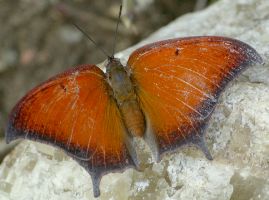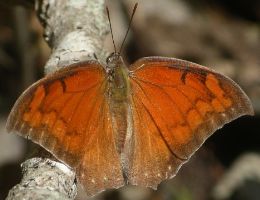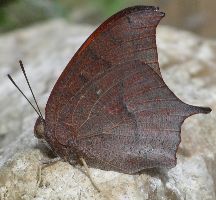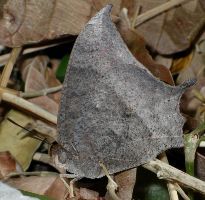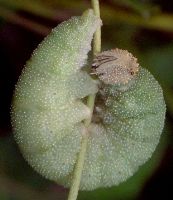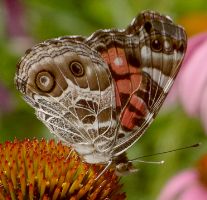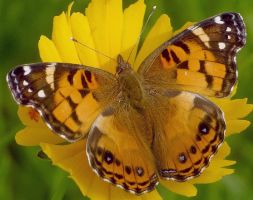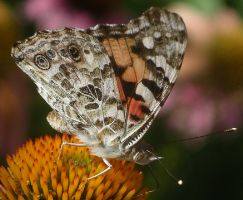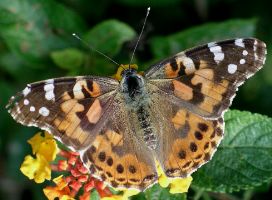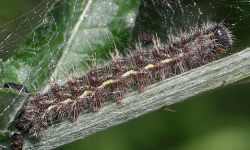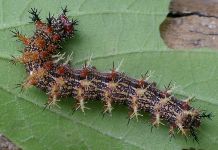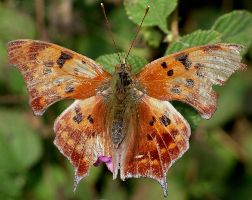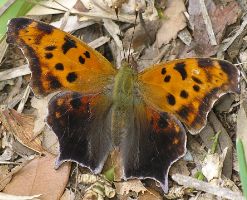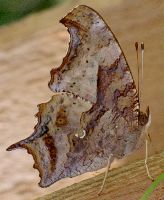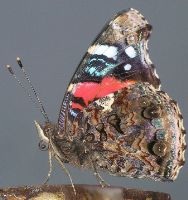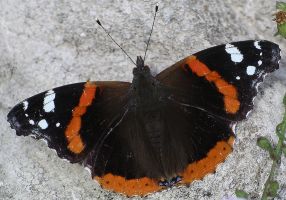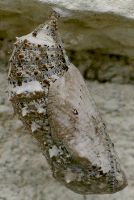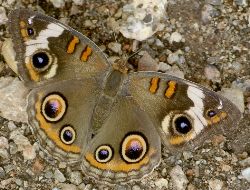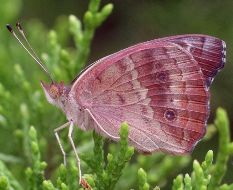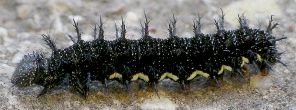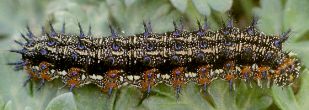
| Nymphalidae ~ Brush-footed Butterflies |
page 1 ![]() page 2
page 2 ![]() page 3
page 3 ![]() page 4
page 4 ![]() page 5
page 5
|
We have two species of leafwings and they look very similar. These are butterflies with orange on the upper sides of their wings but the lower are dull colored for camouflage. While they often perch with their wings closed, they will sometimes open them if threatened, which gives a predator a bright orange target. Then they quickly close them and, in the eyes of many animals, the key color has simply disappeared and they cannot find their intended victim. The leafwings do not visit flowers and instead feed on sap or rotting fruit. While they can sometimes be found on the ground, they are more often seen perched on high branches, where their distinctive silhouette still allows for an identification.
The Goatweed Leafwing (Anaea andria) is considered more common in our area, and it is the only species for which I find caterpillars. The distinguishing features to separate it from the Tropical Leafwing (Anaea aidea) include the length of the small extra tail on the hind wing, located below the major long tail. The Goatweed Leafwing has a very short protuberance while the Tropical Leafwing has a more pronounced extension in this location. This only works on intact individuals, and leafwings are often found in very worn condition so the tails might be missing, as in the accompanying photograph. The color of both leafwings is brilliant orange for males and lighter with heavier markings for females. The Goatweed Leafwing male has almost no markings other than dark edges to its wings, while the Tropical Leafwing has an extra blurry black line that parallels the outer edge. It also has small yellow dots along the edge of the hind wings. The same extra black markings occur on females, but the area between them and the wing edge is a contrasting lighter yellow.
The undersides of the wings of both species are quite distinctive but must be seen rather closely or in the right kind of light. The Goatweed Leafwing is a smooth reddish gray underneath, with a slight sheen to the scales. There are only very light markings. The Tropical Leafwing has a much rougher texture to its scales and they are gray with heavier markings. Both species' caterpillars feed on crotons, and in our area the Goatweed Leafwing prefers Prairie Tea (Croton monanthogynus), a very common weed. The caterpillars make little shelters by tying leaves together, and their head can be seen in the round top entrance hole. They have a very warty look and are light green with a tan head. Another pair of butterflies that are hard to tell apart at a glance are the ladies. Both the American Lady (Vanessa virginiensis) and the Painted Lady (Vanessa cardui) are commonly seen feeding on flowers. They are orange, black and white, and medium-sized.
Some general identification clues for the American Lady include very deeply notched and square-tipped forewings, mostly light orange color on the upper wings towards the center, and small blue centers on the dark dots on the upper sides of the hind wings. On the undersides of the wings, the two large eyespots on the hind wings are the best feature. The Painted Lady tends to have more black markings, more pointed wings, and smaller hind wing spots with no center color on the upper side. The lower hind wing is marked with four small eyespots. The caterpillars of the Painted Lady are rather frequently encountered. They feed on many kinds of plants but I find them mostly on thistles. The variable caterpillars (marked with brown, yellow, black and white, with light colored spines) make a loose nest of webbing, which is unusual for butterflies, and it is often easily visible.
The Question Mark (Polygonia interrogationis) is another oddly shaped orange butterfly that is rather common here. The name comes from a tiny pair of white marks in the center of the underside of the hind wing which usually look like a dot and a parenthesis mark. I think the caterpillars give a much better basis for the name, as they have the habit of curling around when disturbed to form a question mark shape. They feed on elms and hackberries.
The adult Question Marks do not feed at flowers, instead preferring sap and fruit. They often rest in grassy areas near trees, where their closed wings and unusual profile make them almost disappear. The underside markings on the wings can vary from heavy to almost completely light brown. The tops of the wings vary depending on the season. During the summer, the forewings are orange with black spots, while the hind wings are mostly black. The winter form (illustrated by a very worn individual in the accompanying photo) lacks the black hind wings and edges, being more overall brown.
Vanessa atalanta). While the undersides of the wings are a complex pattern of fine lines and colors that serve as camouflage, the upper sides are dark with orange slashes and white dots. The caterpillars tend to be dark, sometimes black, with a yellow line or series of dashes along their sides.
The Common Buckeye (Junonia coenia) is yet another very distinctive nymphalid. The large eyespots that give the butterfly its name also make it easy to identify. Usually seen on flowers or resting on the ground, Common Buckeyes almost always perch with their wings wide open. The underside of wings is rarely visible, but it varies from light gray in the spring to reddish in the autumn.
Pupae of the Common Buckeye are similar in shape to crescents, but they are bigger. The caterpillars are very common on several kinds of garden flowers. They are striped with black and white, with orange on the sides. The most striking feature, which is rarely visible without magnification, is the brilliant blue on the spines. To me, the spines always appear black but in photos (without flash) the blue is stunning. Unfortunately, due to the small size of the illustration here, it is closer to how it looks in real life and the blue doesn't show up. |
page 1 ![]() page 2
page 2 ![]() page 3
page 3 ![]() page 4
page 4 ![]() page 5
page 5
![]()
